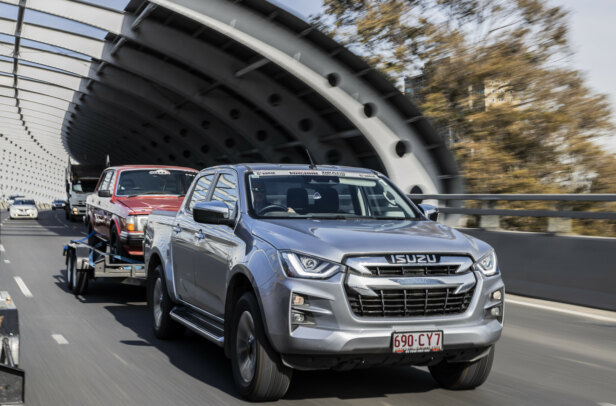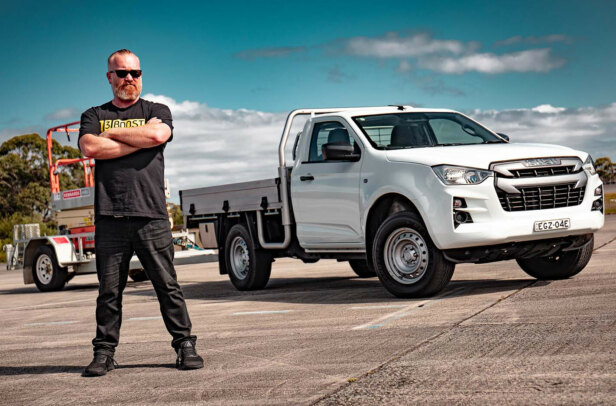Whether it’s a brand-new project or your pride and joy, hauling a car on a trailer can be a daunting task. We’ve all heard horror stories about trailers gone wild and dreams smashed into a thousand pieces (see one example at the bottom of this article), so how do you avoid that fate? You start by following these few simple pieces of trailer theory.
LOADING
Safety is paramount when it comes to hauling cars, and it all starts with evenly distributing the weight on the trailer. This makes for a more stable, predictable mass to haul behind your tow pig.
The general rule for most front-engined cars is to load them nose-first to keep the weight evenly positioned. That said, if you’re hauling your ride sans engine or drivetrain, it can be wise to load it rear-first.
Start with the tow car and trailer parked on firm, flat ground. Chock the tow vehicle’s wheels, put it in Park (or in gear if a manual), and engage the trailer’s handbrake so you don’t push the whole shebang down the road as the vehicle climbs the ramps.
Car-trailer newbies really should have two spotters to assist your progress up the ramps, and if you’re not confident about driving it up there yourself, winch the car on. Once the vehicle is on the trailer, lay a spirit level along the bed so you can check that the load is evenly distributed.
If the nose of the trailer is pointing up or down no matter where the car is positioned on the bed, you need to look at correcting your hitch position. An adjustable drop-hitch can make this task much easier.
You should check the tongue weight of a new load/trailer combo, as this should be between 10 and 15 per cent of the total weight of the loaded trailer. Too much tongue weight pulls the tow vehicle’s front wheels off the ground; not enough tongue weight causes the trailer to be unstable and wag at speed.
To measure tongue weight, put a heavy-duty scale under the jockey wheel and move the car forward on the trailer bed to increase tongue weight until it is within the correct range. A good idea is to mark the deck of the trailer at this spot if you’re going to be hauling that specific vehicle regularly.
Ben Neal, a veteran of both Hot Rod Drag Week and Street Machine Drag Challenge, has one of the hardest-working car trailers in the business. “I reckon my trailer would have nearly 200,000km on it,” he laughs. “I’d probably do 20,000-30,000km per year with it.
“The best advice I can give a trailer newbie is to know where to put your car on the trailer,” he continues. “I try to get 100-150kg of tongue weight for the best tow manners.”
FASTENING THE LOAD
Once the vehicle is positioned, slap it in Park (or in gear for manuals) and engage the handbrake. It is now time to delve into the world of strapping.
Running a lasso strap around each wheel and ratcheting them tight is a popular option for many modern cars but won’t work on fat-tyred vehicles. Some people prefer to run axle straps around the front lower control arms and diff, which are then attached to ratchet straps to hold the car in place. When strapping the control arms, opinions differ on whether the best approach is to cross the straps in an X-pattern to reduce side-to-side movement or run them straight.
Alternatively, you could take a leaf from Benny’s book; he has fitted his trailer with a tie-down system in the bed itself. “It is effectively what is used on a tilt-tray,” he says. “It was a retrofit kit I ordered off the internet for around $1000, and it can be fitted to any steel-bed trailer. It came with straps, channel, mounting plates and tie-down lock bar.
“The convenience of having a car loaded in 10 minutes is the main reason why I did it, and the fact I can have one of my straps come loose and the car is still secure,” Benny continues. “When strapping through the wheels or over the axles, the straps can loosen off, while running straps through wheels can be dangerous because a lot of old-school wheels have sharp edges that can fatigue the straps.”
Benny also suggests bringing spare straps and them checking for wear before trusting them to hold your pride and joy. “I normally check the condition of my straps pretty regularly,” he says.
“I have standard tie-downs as secondaries or spares in case of emergency, which I keep in the back of the ute. I’m not a fan of using conventional straps to tie a car down, because frankly, it takes too long! When you get to the track in the morning, you have a lot to unpack – and pack up again at the end of the day. Plus, ordinary ratchet straps are also noisy, which can be an issue if you’re trying to load a car late at night.”
HAULING THE MAIL
Before hitting the road with your precious cargo safely strapped down, there are a few pre-flight checks you can do that will hopefully stave off disaster. And they actually start before you touch the jockey wheel.
Keeping on top of regular trailer maintenance is something Benny recommends, including remembering to use weight-rated tyres and checking the adjustment of the braking system. “Once a year I’ll strip wheel bearings, but I adjust the brakes fairly regularly,” he says. “I always recommend light truck tyres on a car trailer, too; they’re more durable, cheap and load-rated.”
Once the vehicle is loaded, do a walk-around to check you’ve secured the ramps and attached your safety chains, and ensure the straps are all tight before setting off. Do another quick check of the straps 10 minutes down the road, as they can come loose, especially new straps.
If you’ve never towed a car trailer before, it is highly recommended you take an experienced co-pilot with you the first time, and do some practice runs before your big adventure so you’re used to manoeuvring the whole set-up. You don’t want your first time reversing a trailer down a driveway to be when you’ve got precious metal on the back.
When in motion, remember to leave plenty of room around the trailer and to swing wide around corners. Bumping off kerbs can affect tyre pressures, knock wheels out of round and damage the trailer’s suspension, while plenty of people have remodelled their trailer’s guards by cutting too close to buildings or fences.
Leave yourself plenty of room to gradually slow down in traffic or on hills, because you don’t have the option of panic-braking. Keep an eye on how the trailer is behaving in the mirrors, as this can be an early warning of impending
catastrophe. If the trailer starts swaying, accelerate smoothly to pull it straight. Your natural instinct will be to jump on the picks, but this will likely further unsettle the trailer.
Follow these simple towing guidelines and you’ll be ready to head to Drag Challenge!
WELCOME TO MY NIGHTMARE
Mick Hinchy lived every street machiner’s worst nightmare in July 2020 when a towing crash wrote off his VE Commodore wagon, the brand-new trailer it was on, and his new tow car.
“It was all over in literally three seconds,” he says. “We were heading north up the Hume Highway and I was already slowing down to take it easy down the big hill just before the Mittagong interchange. It already felt loose and floaty when a semi-trailer blew past us, and I think that was just enough to unsettle it all.
“Moments later, we were across all three lanes two or three times, and then the car spun and jack-knifed against the trailer, which drove us into the rock wall on the side of the highway.”
The force of the crash was enough to snap all the straps holding the two-tonne VE on the trailer, yeeting it down the verge, where it came to rest on its side.
“The problem was how I loaded the car and my inexperience with towing; this was the first time I’d ever towed a car,” Mick explains. “The car was too far back on the trailer, as there was a tyre rack on the trailer that prevented me getting the car any further forward. I could see the rear trailer tyres were taking more of the load, but I didn’t know how dangerous that could be. I thought I could take it easy and be okay.”
Having learned from this expensive, heart-breaking lesson that cost him his dream car, Mick has some wise words for novice towers. “The number-one piece of advice I have is to make sure the load is correctly distributed,” he says.
“Another thing not helping me was that the car we were towing weighed more than the tow car, and even though the tow car had been upgraded, it wasn’t enough. Also, properly strap your car to the trailer; think hard about whether the car can move forwards or backwards, especially if a tyre on the car goes flat or something breaks.”
No matter how you attach the car, tighten the rear down first, then snug the fronts up so you don’t change the tongue weight by pulling the car forward on the deck. Remember to tie your loose strap-ends up over the ratchet mechanisms to ensure they don’t come loose.
To minimise load on the corners of the straps, it is a good idea to have your tie-down points welded onto the deck of the trailer. If you have to tie down to the vertical edge of the trailer, run an axle strap over the edge so your tie-down
strap attaches in a straight line.




Comments